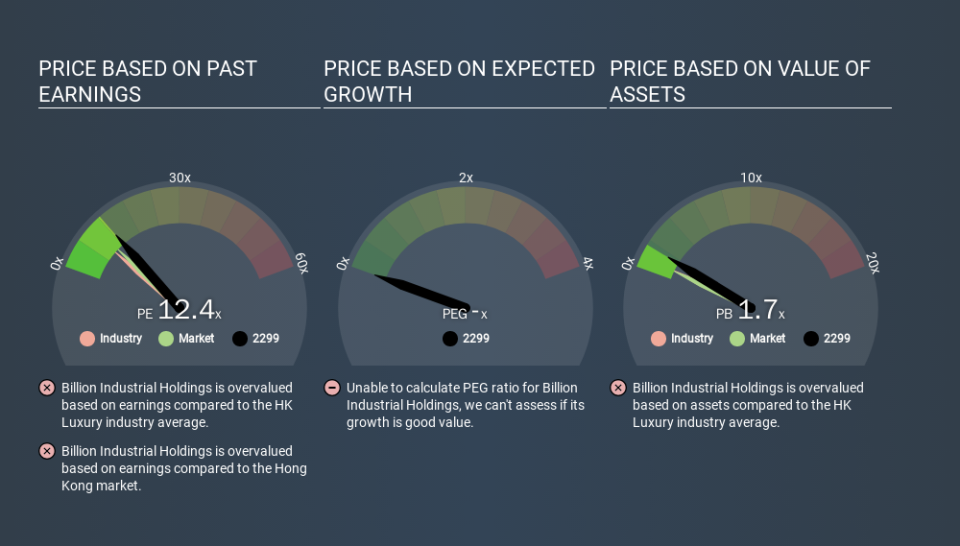What Is Billion Industrial Holdings's (HKG:2299) P/E Ratio After Its Share Price Rocketed?

Those holding Billion Industrial Holdings (HKG:2299) shares must be pleased that the share price has rebounded 37% in the last thirty days. But unfortunately, the stock is still down by 13% over a quarter. But shareholders may not all be feeling jubilant, since the share price is still down 32% in the last year.
Assuming no other changes, a sharply higher share price makes a stock less attractive to potential buyers. While the market sentiment towards a stock is very changeable, in the long run, the share price will tend to move in the same direction as earnings per share. So some would prefer to hold off buying when there is a lot of optimism towards a stock. One way to gauge market expectations of a stock is to look at its Price to Earnings Ratio (PE Ratio). Investors have optimistic expectations of companies with higher P/E ratios, compared to companies with lower P/E ratios.
Check out our latest analysis for Billion Industrial Holdings
Does Billion Industrial Holdings Have A Relatively High Or Low P/E For Its Industry?
We can tell from its P/E ratio of 12.41 that there is some investor optimism about Billion Industrial Holdings. As you can see below, Billion Industrial Holdings has a higher P/E than the average company (9.0) in the luxury industry.
Billion Industrial Holdings's P/E tells us that market participants think the company will perform better than its industry peers, going forward. Clearly the market expects growth, but it isn't guaranteed. So further research is always essential. I often monitor director buying and selling.
How Growth Rates Impact P/E Ratios
Earnings growth rates have a big influence on P/E ratios. When earnings grow, the 'E' increases, over time. That means even if the current P/E is high, it will reduce over time if the share price stays flat. Then, a lower P/E should attract more buyers, pushing the share price up.
It's nice to see that Billion Industrial Holdings grew EPS by a stonking 29% in the last year. And it has bolstered its earnings per share by 32% per year over the last five years. So we'd generally expect it to have a relatively high P/E ratio.
Don't Forget: The P/E Does Not Account For Debt or Bank Deposits
The 'Price' in P/E reflects the market capitalization of the company. That means it doesn't take debt or cash into account. Theoretically, a business can improve its earnings (and produce a lower P/E in the future) by investing in growth. That means taking on debt (or spending its cash).
Such spending might be good or bad, overall, but the key point here is that you need to look at debt to understand the P/E ratio in context.
Billion Industrial Holdings's Balance Sheet
The extra options and safety that comes with Billion Industrial Holdings's CN¥454m net cash position means that it deserves a higher P/E than it would if it had a lot of net debt.
The Bottom Line On Billion Industrial Holdings's P/E Ratio
Billion Industrial Holdings's P/E is 12.4 which is above average (10.1) in its market. With cash in the bank the company has plenty of growth options -- and it is already on the right track. So it does not seem strange that the P/E is above average. What is very clear is that the market has become more optimistic about Billion Industrial Holdings over the last month, with the P/E ratio rising from 9.0 back then to 12.4 today. For those who prefer to invest with the flow of momentum, that might mean it's time to put the stock on a watchlist, or research it. But the contrarian may see it as a missed opportunity.
Investors have an opportunity when market expectations about a stock are wrong. People often underestimate remarkable growth -- so investors can make money when fast growth is not fully appreciated. Although we don't have analyst forecasts shareholders might want to examine this detailed historical graph of earnings, revenue and cash flow.
Of course, you might find a fantastic investment by looking at a few good candidates. So take a peek at this free list of companies with modest (or no) debt, trading on a P/E below 20.
If you spot an error that warrants correction, please contact the editor at editorial-team@simplywallst.com. This article by Simply Wall St is general in nature. It does not constitute a recommendation to buy or sell any stock, and does not take account of your objectives, or your financial situation. Simply Wall St has no position in the stocks mentioned.
We aim to bring you long-term focused research analysis driven by fundamental data. Note that our analysis may not factor in the latest price-sensitive company announcements or qualitative material. Thank you for reading.


